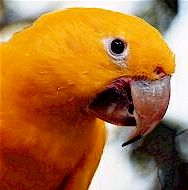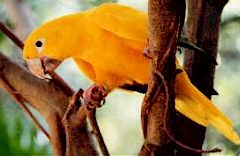|
|
|
Endangered Creatures Website |
|
 |
Some
Brazilians have suggested that the golden parakeet should be
adopted as their national bird because its coloring -yellow and
green- is the same as the national flag. |
|
How
parakeets live |
|
This distinctive bird
forages in the
treetops for fruits, berries,
seeds,
and nuts; it also feeds on some cultivated crops and
favors
corn (maize). Toucans are predators of eggs and
nestlings
in clearings, and monkeys and snakes are predators in the forest.
The golden parakeet is
gregarious,
roosting
with up to nine birds in a single tree-hole, and moving in flocks
of up to thirty between roosting and feeding areas. Breeding
usually lasts from December to April, but some seasonal variation
has been observed, possibly due to changes in weather conditions.
Apparently, breeding and rearing of young is
communal.
Several females lay their eggs in a single
clutch
located in the cavity of an isolated tree 50 to 100 feet tall,
usually in the highest part of the trunk or a high, thick branch.
In captivity, clutch size of a single pair was two to three.
However, a group of three males and three females all cared for
fourteen
chicks. In captive
birds, incubation lasts around 30 days. |
|
Where
they live |
|
The range of the golden parakeet in northern Brazil extends from
northwestern Maranhao west through Para along the Trans-Amazonian
Highway as far as the Tapajos (Amazonia) National Park. Recent
evidence of a population in Rondonia in western Brazil suggests
that previous estimates of range must be expanded and that further
populations may yet be discovered. No estimates of population size
currently exist.
The habitat of the golden parakeet is tropical rain forest, primarily
in
the canopy of dryland forest
in
hilly upland areas. It has
also been seen in
riverine
grasslands, and in seasonally or permanently flooded forest. It
uses tall forest during the dry, non-breeding season, but
seeks
out cleared areas with isolated trees near forests in
breeding season. |
|
Ornithologists have long considered the golden parakeet rare, but some
suggest that early European explorers
were
unable to penetrate deeply enough into the species'
habitat to
accurately assess
its numbers. Where good forest remains, the bird may still be seen regularly,
but
overall numbers have
declined very seriously. |
 |
|
|
What is
happening to their habitat |
|
Habitat destruction is the primary
threat
to the golden parakeet. Wholesale clearing of tropical forest as a
result of road construction and settlement has fragmented the
bird's distribution in Maranhao. Major development projects such
as railroad construction,
lumbering,
cattle ranching, and gold mining have also contributed to the
decline of habitat.
Another significant threat to the golden parakeet is the fact that it is
among the most highly prized birds in the world, selling to
collectors for upwards of $15,000. Despite legal protection,
it is still
smuggled within
Brazil and on an international scale. Ironically, legal protection
of the species may have worked against the parakeet by identifying
it to dealers being of special value, a situation that could be
overcome
by a conservation awareness campaign. In addition to live capture,
the species is
hunted for food
or sport and killed as a pest to
corn
crops.
The only nature reserve currently in the species' western range is the
Tapajos (Amazonia) National Park in Para. The Gurupi Biological
Reserve, created in 1988, needs to be demarcated and
wardened
to protect this and several other important species. Areas between
Tapajos and Gurupi must be protected and managed so that
populations can survive and interbreed. Studies are also necessary
to better determine the golden parakeet's distribution,
population, and habitat, as are measures to control the bird's
exploitation by illegal traders. |
|
Source:
Endangered Creatures Website
|
|
GLOSSARY |
|
forages:
searches for food
(se provee de alimento)
seeds: small hard fruits (semillas)
favors: prefers (prefiere, privilegia)
nestlings: young birds (pichones)
gregarious: forming a group with others of the same kind (gregario,
busca la compañía de su misma especie)
roosting: settling down (conviviendo)
communal: in groups (grupal, en grupos)
clutch: birds hatched at the same time (nidada)
chicks: young birds (polluelos, pichones)
in the canopy
of:
under the shelter
of, protected by (al reparo
de, protegidos
por)
hilly: with hills or small mountains (montañosas)
riverine:
near a river (ribereñas) |
seeks out: looks for, searches (busca)
were unable to: couldn't (no pudieron)
accurately:
exactly (con exactitud)
overall numbers: total figures (los valores totales)
threat: danger, menace (peligro, amenaza)
lumbering:
wood cutting (la explotación forestal)
smuggled: illegally transported (contrabandeado)
overcome: defeated (superada)
hunted: pursued, chased (perseguida)
corn crops: maize yield (las cosechas de maíz)
wardened: officially controlled (vigilada) |
|
|
|
|
 |
|
MAS "ECOLOGIA - VIDA SILVESTRE"
FORO
INICIO |
|